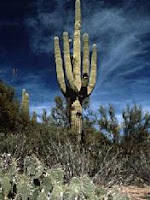With only a few exceptions, the true cacti are found exclusively in the western hemisphere, from Canada to the southern tip of South America, the West Indies, and the Galápagos Islands. Cacti are often referred to as xerophytes, plants adapted to extremely dry conditions and capable of withstanding drying for extended periods. The most obvious characteristic of cacti are the spines, which serve a number of purposes besides protection, such as casting shadows on the cactus to protect it from the sun, reducing leaf surface area, which reduces water loss, and serving as points of condensation for moisture, which then drips down for use by the roots.
 Christmas Cactus
Christmas CactusThe Christmas cacti are a group of bushy perennial cacti growing to a height of about 16 cm (5 in). These cacti are often found in shaded areas in rich, well-drained soils.
 Organ Pipe Cactus
Organ Pipe CactusThe organ pipe cactus grows in parts of Arizona, Baja California, and northern Mexico at elevations below 1000 m (3000 ft). The organ pipe reaches a height of 6.6 m (20 ft) and has white flowers and red fruit.
 Saguaro Cactus
Saguaro CactusThe saguaro cactus, common in Arizona’s desert areas, branches only after it has reached a height of about 5 m (about 15 ft). The saguaro grows very slowly, approximately 2.5 cm (approximately 1 in) per year, and can reach heights of up to about 15 m (about 50 ft). Featured on a United States postage stamp in 1962, the plant’s waxy white blossom is Arizona’s state flower.
 Barrel Cactus
Barrel CactusThere are four species of barrel cactus in the genus Ferocactus growing in parts of Baja California, Mexico, Arizona, and California at elevations below 2000 m (6000 ft). Depending on the species, barrel cactus plants reach a maximum size of 1.6 to 3.3 m (5 to 10 ft). The flowers are generally a yellow, greenish-yellow, purplish-red, or orange color.
 Prickly Pear Cactus
Prickly Pear CactusThe prickly pear cactus is found throughout the southwestern United States, Baja California, and the Sonoran Desert region of Mexico. Prickly pears have whitish, yellow, orange, or red flowers and greenish-brown, yellow, yellowish-green, red, or purple fruit, which are suitable for human consumption. The cactus plants themselves are also edible and are commonly used for livestock feed.
 Jumping Cholla Cactus
Jumping Cholla CactusThe jumping cholla, native to rocky deserts and hillsides of Baja California, northern Mexico, Arizona, and New Mexico, grows to a height of 5 m (15 ft). The plant has lavender flowers and a greenish fruit that grows in a chainlike fashion over a period of years.



